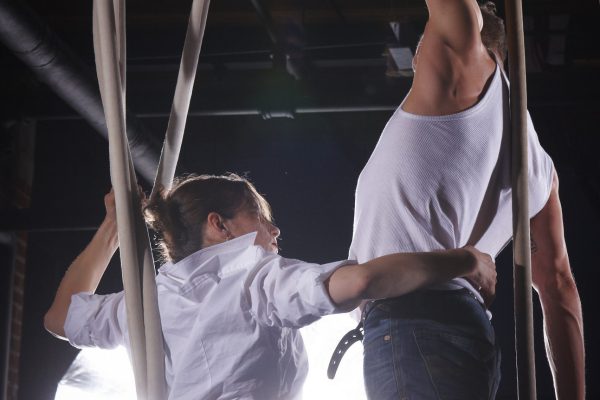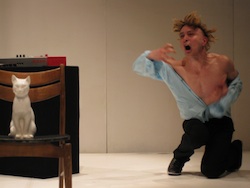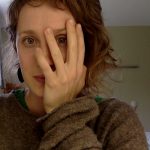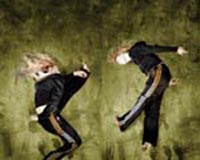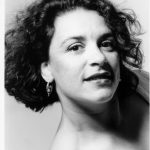I had arrived early, thinking there would be hordes of people, given the free admission and Marie Chouinard’s status as an artist. To my surprise, there were only five of us waiting. Perhaps I was still under the spell of thinking of those begging for the chance to sit opposite Marina Abramovic at her monumental event, The Artist is Present, at MoMA in New York in 2010. Marie Chouinard’s return to solo performance after more than twenty years didn’t have the same kind of intense must-see media push, and the weather was rotten, so maybe that explains things to some extent. Eventually a crowd of about 200 people assembled.
Watching Chouinard in performance is a rare and welcome event. In program notes for In Museum the renowned performer and choreographer invokes Pythia, the prophetess of Delphi, an ancient Greek character who delivered her prophecies in a trance and a language that only priests of the temple knew how to interpret.
Walking into the space, with her long blonde hair loose, Chouinard is dressed in layers of white and beige clothing, with a white hooded cloak, a large white umbrella, white socks and sandals and big wide-rimmed glasses. She circles the room, acknowledging most of the assembled audience with a smile or a glance. She raises her hand to her chest to greet some. These silent encounters set the tone for the ensuing events. In Museum allows spectators to enter the performer’s space, in this case the spacious basement-level Contemporary Art Square at the Montreal Museum of Fine Arts (where one is surrounded by fine work by Betty Goodwin, William Kentridge, George Segal and Annie Pootoogook, among others), to approach Chouinard and whisper secret messages or wishes. She then interprets these intimate confidences in short improvisations. The ‘stage’ is a square of white marley floor in the centre of the space, with various positioned props (a clock or a tissue box, for instance) and the audience sitting on the floor, for the most part, on all sides. Chouinard takes off a few layers, removes her sandals and steps into the space. She appears to drink in the air, lips and throat thirsty. It’s a terrific moment. From there she gets down to the business of meeting the people.
For those who managed to interact with Chouinard, the dances were meaningful and touching (I checked in with a couple of the folks who had stepped forward). The rest of us took delight in all kinds of other pleasures. Watching Chouinard in action, it’s impossible not to appreciate her stamina and focus (the performance ran for three hours, and she was taking requests every five minutes or so, with very brief lie-downs signalling the end of each section). Her surprising humour and goofiness (a white clown nose didn’t disappoint) were a nice complement to her vital eruptions of movement and vocalization (from trills to gurgles to full-bodied screams). The clearly defined physicality, whether it’s the fluttering of her hands and arms or a kind of loose-limbed loping around the stage were familiar to those of us who have watched her work over the years. And there is, in no small measure, her seeming effortless ability to move the assembled throng. There is very little, if any, of the sexualized, primal physicality that so defines much of her stage work.
Trying to divine the requests made by the spectator/participants is a bit futile. Much more rewarding is watching the intimacy of the artist with her public. Some of the eager participants bow to Chouinard, some clasp her hands and she easily wraps her arms around them, smiling broadly, as they share whispers. These touching exchanges elevate the public spectacle into a ritual concerning some ancient and fundamental aspect of our humanity: the need and desire to communicate and connect. The register and intensity of the experience is entirely a private one, but being witness to something so powerful never is.
Tagged: Contemporary, Performance, Performance Art, Montréal , QC
